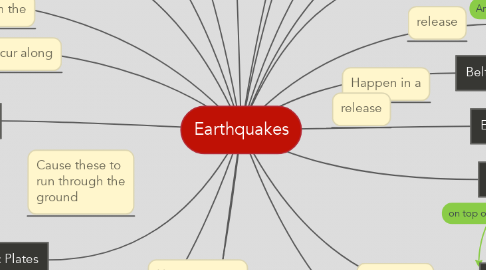Earthquakes
by Lyndy Arong


1. Transform Plate Boundary
1.1. This boundary is where plates are sliding past one another. An example is the San Andreas fault line in California, US
2. Convergent Plate Boundary
2.1. This boundary is where plates collide with each other creating mountains.
3. Divergent Plate Boundary
3.1. Apart, dividing rift that have a physical appearance of a rift boundary or seafloor spreading
4. Convection Currents
4.1. In mantle, cause plate movement
5. Types of Plate Boundaries
6. Asthenosphere
6.1. Another name for Earth's crust
7. occur in the
8. Boundaries
8.1. Lines where tectonic plates meet
9. occur along
10. Tremors
11. Cause these to run through the ground
12. Tectonic Plates
12.1. Are Earth's Crust
12.2. Float on the mantle
13. How strong an earthquake is
14. occur because of the movement of
15. Landforms
15.1. Mountains
15.2. Volcanoes
15.3. Valleys
16. Tension
17. are caused by
18. Magnitude
18.1. How strong the earthquake is
19. Earthquake waves
20. Moment-Magnitude Scale
20.1. More Reliable than Richter Scale
21. P Waves
21.1. Push and Pull Waves
22. S waves
22.1. Shake waves
23. Continental
24. Two types of plates
25. Oceanic
26. Seismometer
27. Seismic Waves
28. release
29. Belt
29.1. Areas where earthquakes occur
30. Happen in a
31. release
32. Energy
33. Focus
33.1. Where the earthquake begins below ground
34. Epicenter
34.1. Directly above focus
35. start at the
36. Commonly occur on
37. Plate Margins
37.1. Destructive
37.1.1. Where on plate goes under another
37.2. Constructive
37.2.1. When two plates float apart
37.3. Collision
37.3.1. When two plates crush against each other
37.4. Conservative
37.4.1. When two plates slide past each otger

